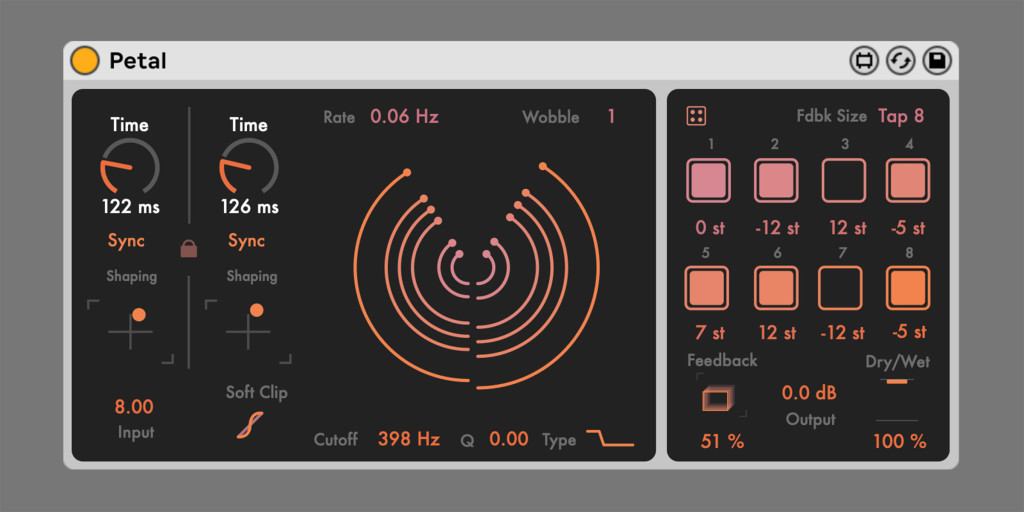Takuma Matsui’s Petal is an expressive 8-tap stereo delay with shaping, pitch shifting, and a separate feedback loop, Max for Live (or Ableton Live Suite). Takuma has created something really special here, from the poetic interface design to elegant control of sound.
I almost don’t need to explain what’s going on here because the interface is perfectly discoverable – especially once you click the dice and mess with the shaping X/Y controls. But once you do get past that appealing UI, and read the clear and concise documentation, you’ll find there are carefully considered details that makes this design sound so good.

Tap loop. Most importantly, there are two separate delay loops. You have the 8-tap delay, indicated by the eight rounded squares on the right-hand side of the interface. These are multiples of the base delay parameters (for left and right) – so set the delay to 10 ms, and the taps will be 10 ms, 20, 30, 40, etc. Each tap can be individually enabled or disabled, and each has its own pitch setting in fifths or octaves. Pitch shifting is precise, fully digital and uncolored. (That’s good, as at this point we have really too many modeled analog delays.) Note that the visualization indicates not just the delay settings, but the taps. You can also click the dice icon to randomize both enabled/disabled taps and pitch shift settings.
Feedback loop. There’s then a separate feedback loop with its own level (at the bottom left), which can scale up to infinite loop (above 99%). At the top right, the Fdbk Size parameter determines the feedback loop length. You might miss that at first – by default, set to Tap 8, you repeat the entire pattern; shorter values overlap feedback loops atop the taps but still quantized. That means this feedback loop always loops in time with the taps, so you get a very particular sound. Takuma also included a limiter since it’s easy to overload the feedback circuit – but as a result, you also get some interesting results if you push up against the limiter.
Shapes and colors. The “Shaping” controls also set Petal apart. These are mapped as an X/Y pad, with time bias on X (from tap 1 to tap 8) and delay time curve on Y (from equidistant to sigmoid – as in, linear to eased).
You then have some nice shaping and coloration tools. There’s a built-in state variable filter. “Wobble” is an LFO fed to the delay time – so think modulation, not just another tape emulation. You can enable subtle soft clipping.
In use. Once you appreciate how Petal works – with its very specific tap and pitch design and shifting, and that feedback – it really feels like an instrument. It has the focus of a piece of beloved hardware.
Here’s a demo of my own. I started with a simple patch in AAS Multiphonics CV-2 running some randomized pulses through the OBJEQ filter, mapped to some knobs, and then messed around with various Petal settings. (Oh yeah, and, Multiphonics CV-2 is on sale at AAS now, but not for much longer!)
I do definitely have a couple of feature requests – even if they’re a bit obvious from other delays. A mid/side mode seems a must. And while I love the swooping vintage-style delay shifts, having a crossfade mode on delay times would open up a whole lot of other sound design possibilities. I don’t want to get too carried away beyond that, though, as part of what makes Petal special is that it is a delay with a particular point of view.
Push 3 standalone compatibility: Testing this shortly (Takuma like a lot of M4L developers doesn’t have a Push 3) – but it should work. I’ll update once I have, as this particular Device looks like a must for standalone mode.
Petal is US$22.
If you buy something from a CDM link, we may earn a commission.
Petal by Rainbow Circuit at Isotonik Studios
There are some other great creations on their shop, including Cascade, a modular take on multi-tap delays.
Really looking forward to time spent playing with more of these!